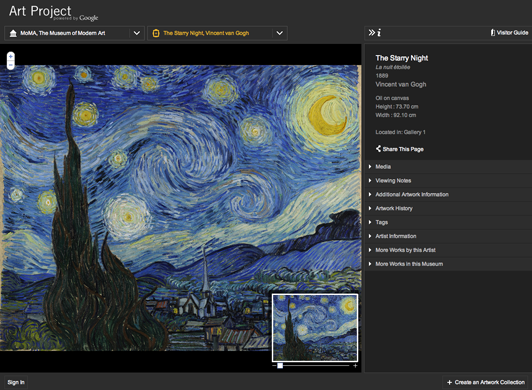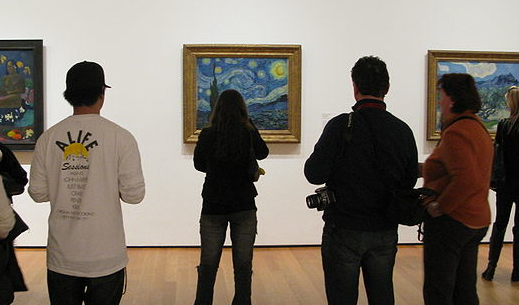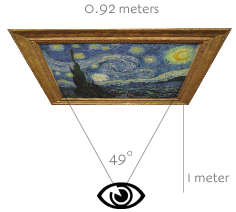Community Embraces New Word Game at Mid-Year Play Day This past Sunday, families at Takoma Park’s Seventh Annual Mid-Year Play Day had the opportunity to experience OtherWordly for the first time. Our educational language game drew curious children and parents to our table throughout the afternoon. Words in Space Several children gathered around our iPads […]
Read more
Real life has a close competitor in the “Art Project,” released by Google last week. Their initial release is a clean, inviting site for browsing over one thousand artworks from 17 of the world’s most famous museums. At least one piece from each of the 17 museums is displayed in gigapixel resolution, so that online visitors can zoom in to the brushstrokes. Each piece also has information about the artists, text or video commentary, bios, and links to related pieces. Some museums have 3D walk-throughs, analogous to Google’s map street views (there are 6000 3D panoramas), and there’s a way to create personal art “collections” to revisit or share later.

The resolution on the gigapixel images is stunning. Consider “The Starry Night,” the famous paining by post-impressionist artist Vincent van Gogh. When you see the painting in real life, you can see the texture of the thick paint strokes which van Gogh created. But aside from a general impression of shimmering, textured paint, it’s hard to see the texture in detail in a busy gallery with normal illumination. Here’s a typical view:

Writing for the Boston Globe, Sebastian Smee said, “If you live far from some of the world’s great museums — and we all do — Google Art Project can give you tantalizing glimpses of their galleries and of individual works of art.” But most of Mr. Smee’s article criticizes the online access: “Call me a curmudgeon, but I remain underwhelmed. It’s not just that Google’s interface is frustrating, or that the choice of viewing possibilities is constrained and seemingly arbitrary… The human eye can grasp the thickness, weight, and texture of the yellow impasto Van Gogh used for the stars and moon in “The Starry Night’’ much more effectively than a camera.”
Is that true? below is a screenshot of the yellow impasto in Google Art Project — and you can zoom in even more:

The Starry Night image in the Google Art Project is super high resolution. The Google image is approximately 45 thousand pixels wide. It is 6 times higher resolution than the naked eye can see from a meter.
 The painting is 74 cm × 92 cm. The maximum spatial resolution of the human eye is measured in cycles per degree. If we consider the vision photoreceptors in the eye to be analogous to pixels, our vision in the most sensitive region, in the fovea of our eye, corresponds to the equivalent pixel spacing of 0.39 arc-minute (Clark, 1990).
The painting is 74 cm × 92 cm. The maximum spatial resolution of the human eye is measured in cycles per degree. If we consider the vision photoreceptors in the eye to be analogous to pixels, our vision in the most sensitive region, in the fovea of our eye, corresponds to the equivalent pixel spacing of 0.39 arc-minute (Clark, 1990).
One degree of vision is 1 / ( 0.39 * 1/60) = 154 pixels. If you stand one meter from a painting, a 0.92 meter wide painting uses a width of 2 * arctan ( 0.92 / 2 ) degrees = 49° of your vision. The equivalent number of pixels which you can see is = 49 * 154 = 7546 pixel wide — the limit of resolution of our eye — any higher pixel density would look the same. You would need to look at the painting with your eye 7 cm (just under 3 inches) away to see the same level of detail. Brian Croxall notes that this is much higher resolution than the commercial image library ARTstor gives to schools and libraries.
Seeing details is important, but the relative importance of seeing detail vs. seeing real 3D is debatable. An article in the Washington Post, reported skeptical comments from museum directors, for example, Brian Kennedy, director of the Toledo Museum of Art in Ohio, said the gigapixel images can bring out details that might not be visible to ordinary museum-goers in a gallery. But scholars will still want a three-dimensional view of the art, which even a very high-resolution two-dimensional image can’t provide.
In any event, the degree of access in this visually appealing, easy to use, highly publicized and free web site is unparalleled. Without it, images of this iconic painting are hard for the general public to appreciate in detail, unless they buy a (two-dimensional) poster or book. That painting is located at MoMA in midtown Manhattan. Admission to the MoMA costs $20 for adults, $12 for students, and free on Friday nights. MoMA has approximately 2.1 million visitors per year, averaging 6.7 thousand visitors per day they are open — 16 visitors per minute — many of whom are interested in the same famous van Gogh painting. Despite being painted in 1889, and long since out of copyright, MoMA maintains strict control over photos which visitors might want to take home or share. According to their guidelines: “Still photography for personal use is permitted in collection galleries only… No photographs or videotapes may be reproduced, distributed, or sold without permission from the Museum.” — All the more reason that MoMA and the other 17 museums are to be commended for facilitating this project.
This is one of the reasons that Jonathan Jones writes at the Guardian says:
“Google’s Art Project is a profoundly enriching encounter, one that really starts to break down the difference between viewing a reproduction and seeing it in the flesh. It deserves to succeed.”
And Julian Raby, director of the Smithsonian’s Freer Gallery of Art in Washington said:
“The giga-pixel experience brings us very close to the essence of the artist through detail that simply can’t be seen in the gallery itself … Far from eliminating the necessity of seeing artworks in person, Art Project deepens our desire to go in search of the real thing.”
Dr. Raby’s comments echo those by made by Walter Benjamin makes in his 1936 essay, “The Work of Art in the Age of Mechanical Reproduction.” Brian Croxall points out in the essay, Benjamin considers the effect that photography, phonography, lithography, and more have on the “aura” or authenticity of an art work. On the other hand, he noted, “Even the most perfect reproduction of a work of art is lacking in one element: its presence in time and space, its unique existence at the place where it happens to be.” Benjamin is clear that reproductions are better than originals in at least one concrete way:
…process reproduction is more independent of the original than manual reproduction. For example, in photography, process reproduction can bring out those aspects of the original that are unattainable to the naked eye yet accessible to the lens, which is adjustable and chooses its angle at will. And photographic reproduction, with the aid of certain processes, such as enlargement or slow motion, can capture images which escape natural vision.
To examine this more closely with students, The New York Times Learning Network posted a lesson plan, “Real vs. Virtual: Examining Works of Art Online.”
This project did not start as an official Google strategy. Nelson Mattos, Google’s vice-president for engineering, said the Google Art Project started off as one of the company’s “20% projects.” (All Google employees to take a fifth of their time away from their regular day job, to work on innovations.) Google managed all theartwork photography, capture of the Street View imagery, and negotiations with museums. Negotiations could be a drag, and some museums resisted giving free access to their images. Absent are two of the most popular and important museums, the Louvre and the Musee d’Orsay, both in Paris. Amit Sood, leader of the Google Art Project, said “We approached as many museums as we could…But you can only wait so long for people to come on board. We just decided to stop at 17.” Google outsourced some of the design to a media agency, Schematic. In an interview with CNET, Jason Brush, the executive vice president for user experience at Schematic said:
“One of the first issues we had to face was making sure that the site wasn’t itself a meta-museum. The museums themselves have the cultural and civic onus to present the artworks in their collections in whatever way that’s appropriate to their mission. We didn’t want to usurp that. So, the pressure stemmed from not just making sure that the site was enjoyable and easy-to-use because of it’s cultural value, but also because we needed to create a model that drew a clear distinction between the live, in-person museum-going experience…a whole new model for viewing art… We did make some design decisions vis-a-vis unique aggregation of content from many museums. For instance, on the home page, we chose to randomize which museum gets highlighted on load. We didn’t want it always to be the museum at the top of the list.”
Elizabeth Merritt, founding director of AAM’s Center for the Future of Museums, called the walk-through technology an interesting experiment, and the kind of experiment that most museums can’t produce on their limited budgets. She liked the personalization, citing that “It certainly fits with the research we’ve been doing that people like to create their own experiences and their own mash-ups and share them with other people,” but she questioned the appeal of looking at art and galleries on a computer screen.
Marsha Semmel, deputy director for museums at the Institute of Museum and Library Services, said in the Post article that online collections should strive to create connections between material held by different institutions.
Check out the van Gogh painting at Google Art Project.


07 Mar 2011, 3:33 pm
[…] companies are moving into this space. For example, see our recent post about “The virtual vs. the real: Giga-resolution in Google Art Project” where Google collected deliciously high-resolution photos, metadata, and interesting […]
11 Jan 2013, 12:13 pm
[…] -article originally from idea.org (http://www.idea.org/blog/2011/02/14/the-amazing-giga-resolution-images-of-google-art-project/) […]